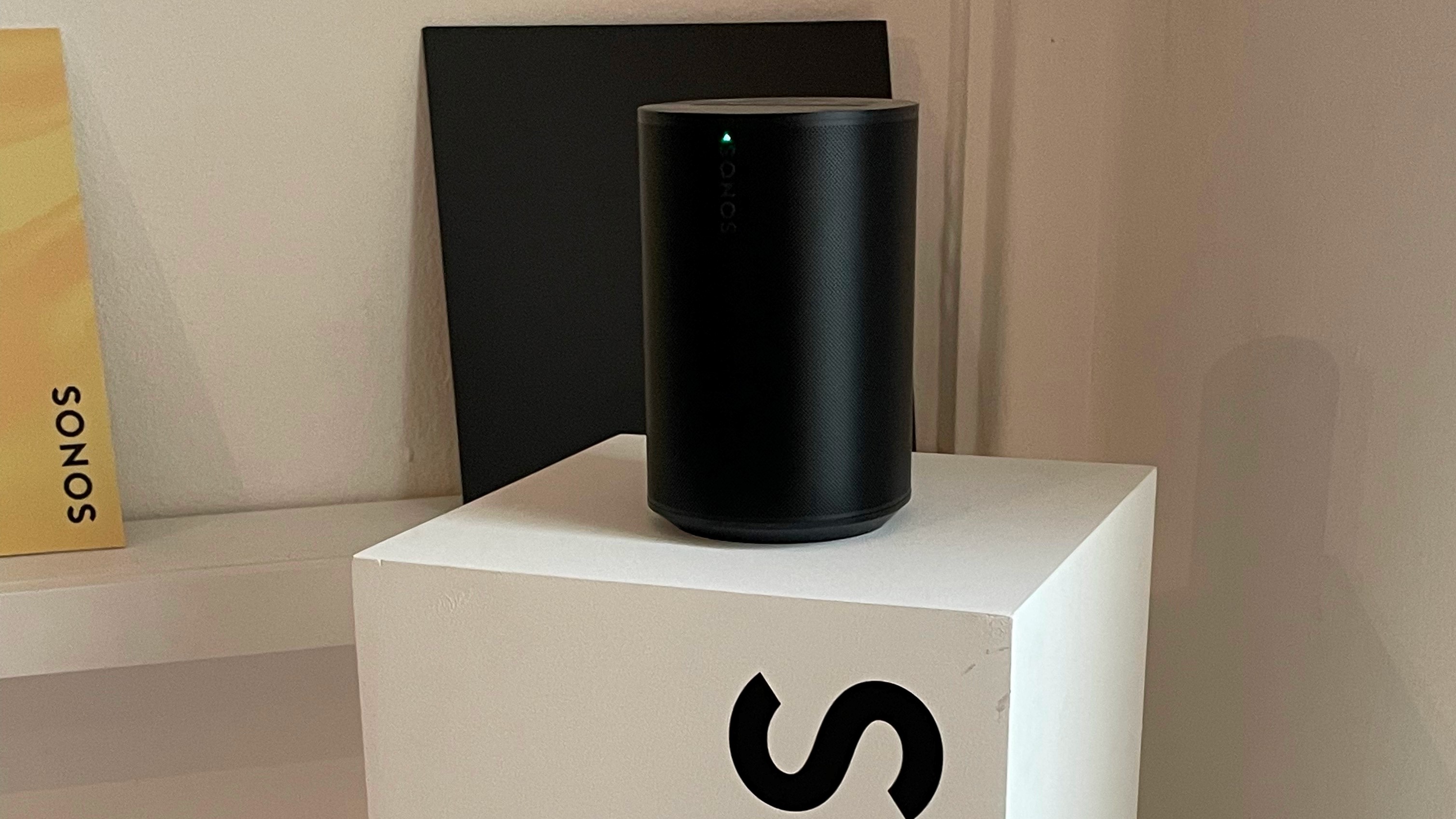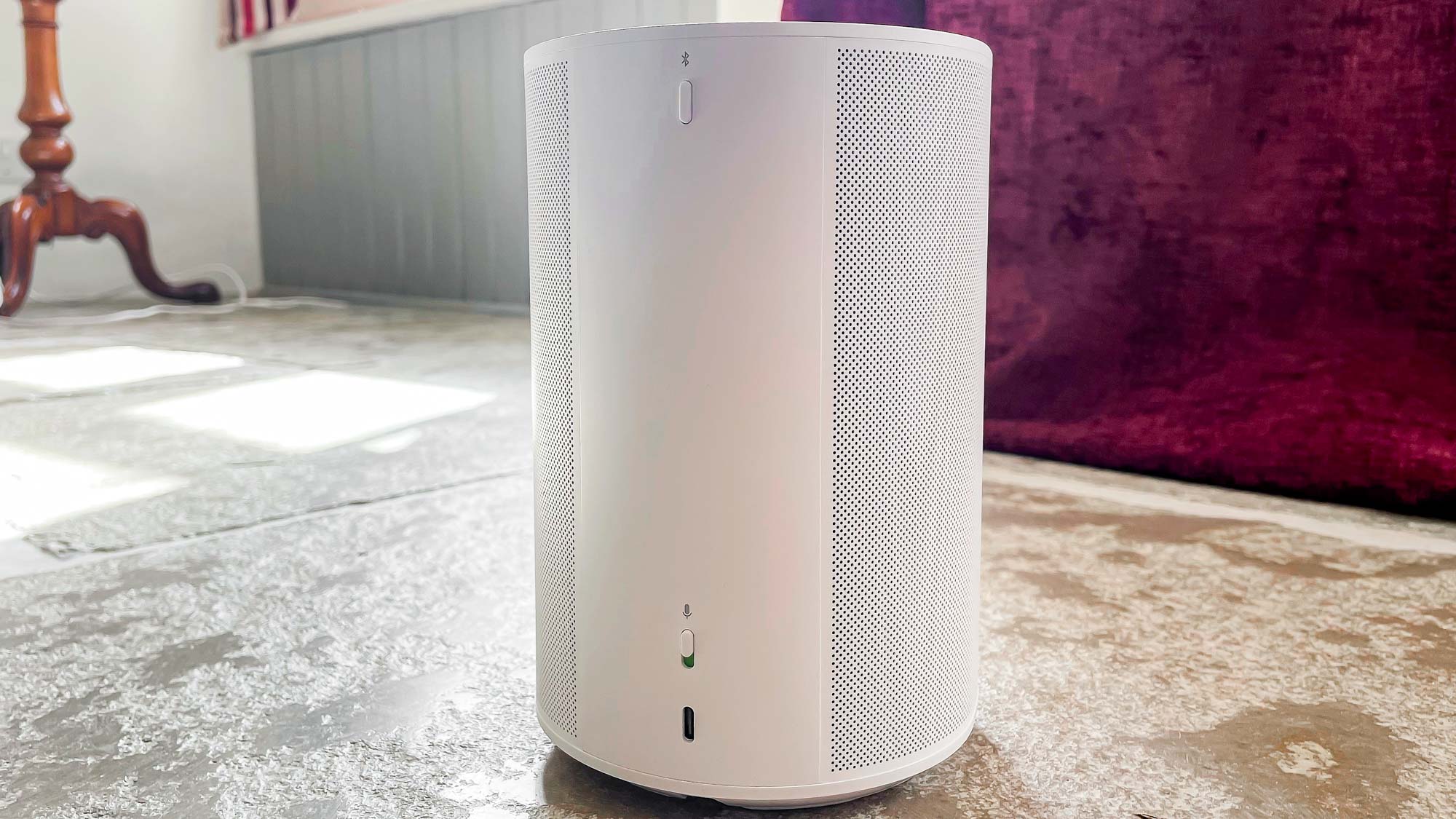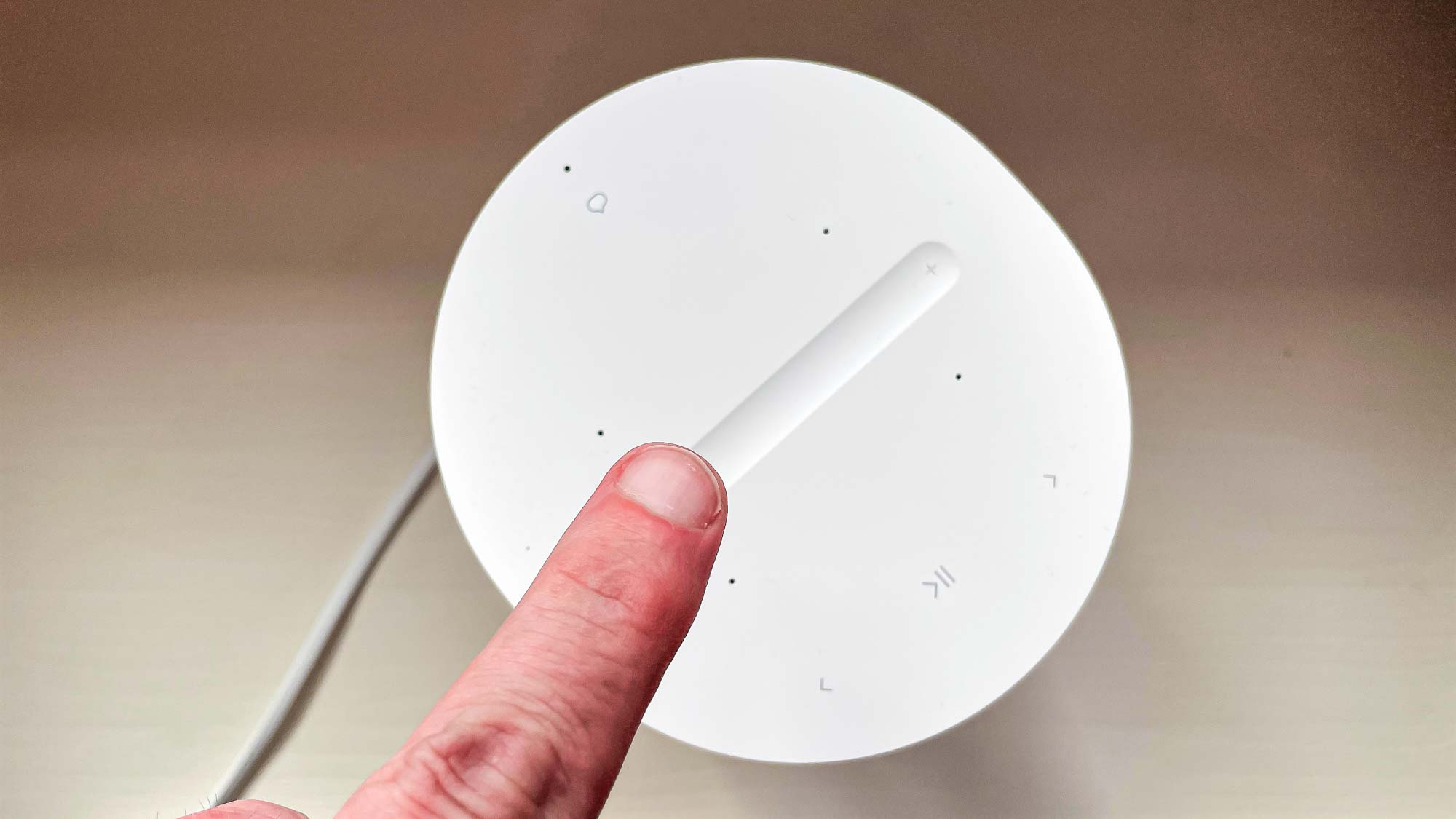Tom's Guide Verdict
As the replacement for the Sonos One, the Era 100 smart speaker ups the performance with bigger sound and improved Bluetooth connectivity, and it lets you play from all the top streaming services as well as a turntable.
Pros
- +
Dual tweeters for stereo sound
- +
Larger woofer pumps out more bass than Sonos One
- +
Wi-Fi 6 and Bluetooth wireless support
- +
USB-C line in for external audio sources
- +
Alexa and Sonos Voice enabled
Cons
- -
No Google Assistant support
- -
More expensive than Sonos One
Why you can trust Tom's Guide
Price: $249 / £249 / AU$399
Colors: Black, white
Size: 7.2 x 4.7 x 5.1 inches
Weight: 4.4 pounds
Speakers: 2 tweeters, 1 woofer
Wireless: Wi-Fi 6, Bluetooth 5.0, Airplay 2
Ports: 1x USB-C
Although the Sonos Era 100 heralds the entry point to the brand new Era lineup, the Era 100 is also the successor to the extremely popular Sonos One smart speaker — to find out the key differences between the new Sonos Era 100 and the original Sonos One, check out our Sonos Era 100 vs. Sonos One face-off.
While these are undeniably big boots to fill, it also faces stiff competition from another recent arrival in the smart speaker world with the Apple HomePod 2, so be sure to check out our Sonos Era 100 vs. Apple HomePod 2 face-off.
As with all smart speakers by Sonos, the Era 100 enables listeners to stream music from dozens of streaming services via its robust system control app, along with the ability to connect to other Sonos speakers and products on your home network. Along with built-in support for Alexa and Sonos voice assistants, the Era 100 also introduces Bluetooth wireless connectivity as well as a wired option that can connect to external sources including one of the best turntables. It joins the Era 300 spatial audio speaker, and both officially go on sale on March 28.
For this Sonos Era 100 review, I streamed radio, podcasts, and played dozens of my favorite music tracks to see how it would fare against some of the best smart speakers and best Bluetooth speakers available to buy today.
Here is my review of the Era 100's design, performance, new features and more. Read on to see if the Era 100 is right for you.
Sonos Era 100 review: Price and availability

The Sonos Era 100 will cost $249 / £249 / AU$399 when it goes on sale on March 28 through the Sonos website and online retailers. Black or white color options are available.
By comparison, the Sonos One costs $219 while the Sonos One SL (which doesn't have smart speaker capabilities) is $199. The Sonos One and the Sonos One SL will remain on sale while stocks last. Although these models are being phased out, they will continue to be supported by Sonos.
Get instant access to breaking news, the hottest reviews, great deals and helpful tips.
Sonos gives you a little discount if you purchase multiple devices — pick up a pair of Era 100s, and you can save $30 versus buying them separately.
Sonos Era 100 review: Design

The Era 100 doesn't look too dissimilar to the Sonos One, but boasts a number of improvements, including a second tweeter for stereo sound from a single unit, as well as Wi-Fi 6 and Bluetooth wireless connectivity. As with the Sonos One, the Era 100 can be used as a single music speaker or as a pair of rear speakers in a Sonos Arc, Sonos Beam, or Sonos Ray soundbar setup.
The Era 100 has more of a rounded design than the Sonos One and is a little larger. It measures 7.18 x 4.72 x 5.14 inches, and weighs 4.44 pounds (around 2kg). That's a little heavier than the Sonos One's 4.08 pounds (around 1.85kg), but there's not a huge difference in the footprint.
Touch controls have been upgraded, and the Era 100 has a small groove running through the middle, which lets you slide your finger to increase or decrease the volume. You can also tap on either side to achieve the same effect. Towards the front of the top of the Era 100 are buttons for play/pause, reverse, and forward.
Internally, the Era 100’s two tweeters are angled left and right to offer a wide stereo soundstage, and it has a 25% larger woofer driver than what's fitted to the Sonos One. This new driver arrangement enables stereo sound from a single speaker unit said to achieve 270 degrees of dispersion — although you can also pair two Era 100s together for a wider stereo soundstage from speakers placed at opposite ends of the room — while the larger woofer driver aims to improve bass performance.
On the underside of the Era 100 is its plug for power, while at the back of the unit there’s a button to activate Bluetooth pairing, and a switch to turn the Era 100’s microphones off — for those times you don’t want Alexa to listen to you.
Sonos Era 100 review: Features and connectivity

The Era 100 supports Wi-Fi 6 and along with the Era 300 is one of the first Sonos speakers to be Bluetooth wireless compatible. It also works with AirPlay 2 on Apple devices using iOS 11.4 and higher. Instead of an Ethernet port, though, the Era 100 has a USB-C port on the back. Sonos will sell adapters that can provide an Ethernet connection and line-in to make it compatible with line-level turntables. A Combo Adapter providing Ethernet and 3.5mm line-in connectivity costs $39.99, while a USB-C Line-In Adapter costs $19.99.
I like that you can connect the Era 100 to a turntable, and with Bluetooth connectivity integrated, it’s now possible to connect the speaker wirelessly to a TV with Bluetooth support, making it a remarkably effective TV sound upgrade.
The Sonos Era 100 supports Amazon Alexa for smart home duties and its own Sonos Voice Assistant, though this only allows you to control music playback. At the time of writing, there's no support for Google Assistant due to on-going wranglings over patent litigation between the two companies, but this may be added at a later date via a firmware update.
Trueplay and adjustable EQ are onboard and compatible with both iOS and Android devices. With an Android device, Trueplay uses microphones built into the Era 100 speaker. Users with an iOS device can also use this method (referred to as Quick Tuning in the Sonos app) or the traditional method (referred to as Advanced Tuning), which uses the microphones in your iPhone or iPad and requires you to move around the room.
Sonos Era 100 review: Sound quality

I’ve listened to the Sonos One in many different situations over the years; as a single speaker placed in different locations around the home, a stereo pair placed on a sideboard in my dining room, and as rear surrounds in numerous home theater setups. So, as the successor, the Era 100 has a lot to live up to if it’s going to better the audio performance of the Sonos One for all kinds of installations.
Thankfully, the Era 100 elevates the sound performance for its new entry-level home speaker with twin tweeters for stereo sound from a single cabinet, and a larger woofer for richer-sounding bass. The sound balance from the new Era 100 is a noticeable step up on the Sonos One, with a good amount of bass energy, even at low volume levels for background listening, and a nicely detailed high frequencies.
As with other Sonos speakers, Trueplay can be used to tune the Era 100 to your surroundings, but during my testing placing the speaker in different locations around the home, I found the sound balance to be nicely judged without any additional EQ tinkering or room tuning.
Much like the Denon Home 150 smart speaker I reviewed recently, the Sonos Era 100 doesn't have the bass depth and punch to resolve the full bass power of "Dangerous" by Big Data (feat. Joywave) as featured in my 5 best bass tracks to give your music system a workout, but there’s plenty of coherent energy on display despite the demanding bass line of the track.
Midrange clarity had just the right balance, and radio voices and vocal clarity were always convincing and expertly conveyed with whatever song or radio show I was streaming. Playing Elbow’s “Gentle Storm” via Tidal HiFi sounded tremendous, with a great balance of the percussive element in the background and the vocal center stage. The stereo soundstage is perhaps a bit narrow even with the Era 100’s twin tweeter arrangement, but it’s a remarkably strong performance all the same. If you want a more expensive stereo performance, you’ll need two Sonos Era 100s paired together in stereo or the Sonos Era 300 with six speakers and spatial audio support.

I had one Era 100 for this review, so I wasn’t able to try a pair out as surround speakers as part of a Sonos home theater setup. Based on the sound balance I’ve heard elsewhere though, I imagine they would be tremendously effective although they won’t support the height element in Dolby Atmos soundtracks. Once again, for that you’ll need the Sonos Era 300 partnered with a Sonos Arc soundbar.
The addition of Bluetooth wireless to the Era 100 brought a boost to my TV sound I wasn’t anticipating, though. I discovered I was able to pair my Samsung TV to the Sonos and use it instead of the TV’s built-in speakers. The sound was rich and more powerful than the TV’s own internal speakers, and I can imagine a stereo pair making an even greater improvement, and an effective alternative to a soundbar.
Sonos Era 100 review: Verdict

The Sonos Era 100 might not look majorly different to the Sonos One, but the boost to connectivity and performance definitely moves the company’s entry-level smart speaker into a new era. The price increase to $249 (up from $219 for the Sonos One) feels right given the upgrades the Era 100 brings, although unlike Apple’s more expensive HomePod 2 ($299), there’s no spatial audio support.
Even with Google Assistant support MIA due to ongoing litigation over smart speakers and voice control technology between the two companies, the Era 100 is a well-rounded smart speaker and a great addition to Sonos’ ecosystem.
More from Tom's Guide
- The best smart speakers to buy right now
- Discover how Sonos works
- 5 ways to make your Sonos speaker sound even better

Lee was Tom's Guide's audio editor, where he covered all things audio for Tom's Guide, including headphones, wireless speakers and soundbars and loves to connect and share the mindfulness benefits that listening to music in the very best quality can bring. As a former editor of the U.K.'s Hi-Fi Choice magazine, Lee is passionate about all kinds of audio tech and has been providing sound advice to enable consumers to make informed buying decisions since he joined Which? magazine as a product tester in the 1990s. Lee has joined the passionate audio experts at audiograde.uk where he writes about luxury audio and Hi-Fi.


